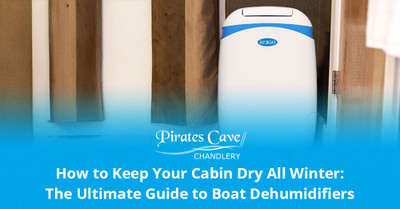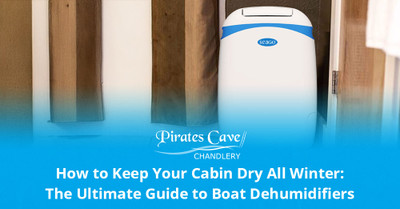17th Oct 2025
When the boating season comes to an end and your vessel is left to rest through the winter months, one of the biggest challenges boat owners face is dampness. Cold, wet weather and a lack of ventilation can quickly lead to mould, mildew, and that musty “boat smell” we all dread.
A boat dehumidifier is one of the simplest and most effective tools for keeping your cabin and your investment dry and protected all winter long. In this guide, we’ll cover everything you need to know about choosing, using, and maintaining a dehumidifier on your boat.
Why Winter Moisture Is a Problem for Boats
Even when a boat is securely stored, moisture can still creep in from the air, bilges, and hull. Over time, this causes mould and mildew to appear on upholstery and soft furnishings, condensation to form on windows and bulkheads, corrosion in electrical components, and even wood rot in joinery and flooring. The combination of cool temperatures, high humidity, and poor airflow makes a closed-up boat the perfect environment for damp problems to thrive.
That’s where a dehumidifier comes in.
How a Boat Dehumidifier Works
Dehumidifiers pull in moist air, extract the water, and release dry air back into the cabin. Over time, this process reduces the relative humidity - ideally keeping it between 40% and 50% for boats.
There are two main types of dehumidifiers used on boats: compressor (also known as refrigerant) and desiccant. Compressor dehumidifiers work best in warmer conditions. They use a refrigerated coil to condense moisture and are energy-efficient when the cabin temperature is higher, making them great for summer or heated boats. However, they lose efficiency when temperatures drop below 15°C, which makes them less ideal for unheated winter storage.
Desiccant dehumidifiers, on the other hand, use a special material to absorb moisture, releasing dry, warm air in return. They perform exceptionally well in low temperatures, gently warm the air to help prevent condensation, and tend to be quieter and more compact. The trade-off is that they use slightly more energy. For UK winter storage, a desiccant dehumidifier is generally the better choice.
Where to Place a Dehumidifier Onboard
Placement is key to getting the most out of your dehumidifier. The main cabin or saloon is usually the best spot, as it allows air to circulate evenly throughout the boat. It’s important to position the unit away from bulkheads and large pieces of furniture so air can flow freely. You’ll also want it near a safe, dry electrical outlet.
Leave doors, lockers, and cupboard lids open so the dry air can reach every corner of the interior. If your dehumidifier has a continuous drain hose, you can route it into a sink, bilge, or cockpit drain to avoid having to empty the water tank regularly.
Using a Boat Dehumidifier During Winter Storage
During winter storage, your dehumidifier should ideally run continuously, controlled by its built-in humidistat so it automatically switches on and off as needed. Setting the humidity level around 45% will prevent both dampness and over-drying.
Before switching it on, check that your power supply is safe. Use a marina-approved shore power connection and ensure all cords and plugs are dry and elevated off the floor. Leave internal doors, cupboards, and hatches open so air can move freely, and make sure to remove any perishables or damp materials that could rot or hold moisture while the boat is closed up.
Electric vs. Non-Electric Dehumidifiers
If your boat is stored somewhere without access to electricity, you can still fight moisture using non-electric moisture traps. These use desiccant crystals or calcium chloride to absorb moisture from the air. They’re ideal for lockers, cupboards, and smaller spaces, and are inexpensive and maintenance-free, though not as powerful as an electric dehumidifier.
Many boat owners find the best solution is to combine both approaches - running an electric dehumidifier in the main cabin while placing smaller non-electric moisture traps in hard-to-reach areas.
Choosing the Right Boat Dehumidifier
When shopping for a dehumidifier, look for features such as automatic shut-off when the tank is full, a continuous drainage option, low-temperature operation (ideally down to 1°C), and a built-in humidistat or timer for convenience.
At Pirates Cave Chandlery, we stock a wide range of marine-grade dehumidifiers and moisture control products designed specifically for boat storage and onboard use, helping you keep your cabin dry all year round.
The Long-Term Benefits of Using a Boat Dehumidifier
A good dehumidifier is one of the most worthwhile investments a boat owner can make. By preventing mould, damp, and odours, it protects your boat’s interior and reduces long-term maintenance costs. It also helps preserve electronics, woodwork, and upholstery, and ensures your boat is fresh and ready to enjoy as soon as spring arrives.
In the long run, this small piece of equipment can save you hundreds, if not thousands, of pounds in repair costs caused by unchecked moisture damage.
Final Thoughts
Winterising your boat isn’t just about draining systems and covering the deck - controlling humidity is just as important. A reliable dehumidifier ensures your cabin stays dry, fresh, and free from mould all winter long, protecting both comfort and value.
Whether your boat is stored in a marina, on the hard, or even at home, maintaining the right humidity levels will make all the difference when the new boating season begins.
Explore the full range of boat dehumidifiers and moisture absorbers at Pirates Cave Chandlery, and make damp one less thing to worry about this winter.



